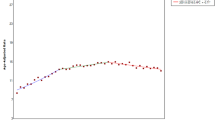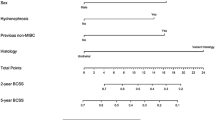Abstract
Background
To evaluate the risk factors for invasive bladder cancer and to develop a predictive model for the improvement of individual comprehensive therapy for invasive bladder cancers.
Materials and methods
The records of 356 patients with invasive bladder cancer, operated on at three Chinese medical institutes, were reviewed. The Cox proportional hazards regression model was used to assess the clinical and pathological variables affecting disease-free survival (DFS). The regression coefficients determined by Cox regression analysis were used to construct a predictive index (PI). PI was used to categorize the patients into different risk groups. Kaplan–Meier survival curves followed with log-rank test were plotted to compare the difference.
Results
Tumor configuration (RR = 1.60, P = 0.01), multiplicity (RR = 1.41, P = 0.04), histological subtype (RR = 2.13, P < 0.01), tumor stage (RR = 2.50, P < 0.01), tumor grade (RR = 2.35, P < 0.01), node status (RR = 2.48, P < 0.01), and neoadjuvant chemotherapy (RR = 0.46, P = 0.02), had independent prognostic significance for DFS. PI = 0.47 × (configuration) + 0.34 × (multiplicity) + 0.76 × (tumor histological subtype) + 0.92 × (stage) + 0.86 × (grade) + 0.91 × (node status) − 0.79 × (neoadjuvant chemotherapy). The range of PI was −0.32 to 6.52, which was equally divided into three risk groups with significant differences on Kaplan–Meier curves and a log-rank test (P < 0.01). Meanwhile, the patient’s probability of survival could be calculated by PI.
Conclusions
Seven factors (tumor configuration, multiplicity, histological subtype, tumor stage, tumor grade, node status, neoadjuvant chemotherapy) affect the prognosis after radical cystectomy (RC) for invasive bladder cancer. PI can be used to optimize the individual comprehensive therapy. Given fewer perioperative complications, fast recovery from surgery and relatively satisfactory quality of life, ureterocutaneostomy, and ileal conduit are suitable for the patients with short expected life spans.


Similar content being viewed by others
References
Shariat SF, Karakiewicz PI, Palapattu GS et al (2006) Outcomes of radical cystectomy for transitional cell carcinoma of the bladder: a contemporary series from the Bladder Cancer Research Consortium. J Urol 176:2414–2422. doi:10.1016/j.juro.2006.08.004
Dhar NB, Klein EA, Reuther AM et al (2008) Outcome after radical cystectomy with limited or extended pelvic lymph node dissection. J Urol 179:873–878. doi:10.1016/j.juro.2007.10.076
Matos T, Cufer T, Cervek J et al (2000) Prognostic factors in invasive bladder carcinoma treated by combined modality protocol. Int J Radiat Oncol Biol Phys 46:403–409. doi:10.1016/S0360-3016(99)00385-5
Stein JP, Lieskovsky G, Cote R et al (2001) Radical cystectomy in the treatment of invasive bladder cancer: long-term results in 1054 patients. J Clin Oncol 19:666–675
Ali-El-Dein B, Sarhan O, Hinev A et al (2003) Superficial bladder tumours: analysis of prognostic factors and construction of a predictive index. BJU Int 92:393–399. doi:10.1046/j.1464-410X.2003.04360.x
Cindolo L, de la Taille A, Messina G et al (2003) A preoperative clinical prognostic model for non-metastatic renal cell carcinoma. BJU Int 92:901–905. doi:10.1111/j.1464-410X.2003.04505.x
Oosterlinck W, Lobel B, Jakse G et al (2002) Guidelines on bladder cancer. Eur Urol 41:105–112. doi:10.1016/S0302-2838(01)00026-4
Cam K, Yildirim A, Ozveri H et al (2002) The efficacy of neoadjuvant chemotherapy in invasive bladder cancer. Int Urol Nephrol 33:49–52. doi:10.1023/A:1014496602067
Stein JP (2006) Improving outcomes with radical cystectomy for high-grade invasive bladder cancer. World J Urol 24:509–516. doi:10.1007/s00345-006-0111-1
Matsumoto K, Shariat SF, Casella R et al (2003) Preoperative plasma soluble E-cadherin predicts metastases to lymph nodes and prognosis in patients undergoing radical cystectomy. J Urol 170:2248–2252. doi:10.1097/01.ju.0000094189.93805.17
Ohlsson G, Moreira JM, Gromov P et al (2005) Loss of expression of the adipocyte-type fatty acid-binding protein (A-FABP) is associated with progression of human urothelial carcinomas. Mol Cell Proteomics 4:570–581. doi:10.1074/mcp.M500017-MCP200
Leissner J, Ghoneim MA, Abol-Enein H et al (2004) Extended radical lymphadenectomy in patients with urothelial bladder cancer: results of a prospective multicenter study. J Urol 171:139–144. doi:10.1097/01.ju.0000102302.26806.fb
Widmark A, Flodgren P, Damber JE et al (2003) A systematic overview of radiation therapy effects in urinary bladder cancer. Acta Oncol 42:567–581. doi:10.1080/02841860310014408
Louie-Johnsun MW, Braslis KG, Murphy DL et al (2007) Radical cystectomy for primary bladder malignancy: a 10 year review. ANZ J Surg 77:265–269. doi:10.1111/j.1445-2197.2007.04031.x
Herr HW, Dotan Z, Donat SM et al (2007) Defining optimal therapy for muscle invasive bladder. Can J Urol 177:437–443. doi:10.1016/j.juro.2006.09.027
Parisi S, Troiano M, Corsa P et al (2007) Role of external radiation therapy in urinary cancers. Ann Oncol 18:157–161. doi:10.1093/annonc/mdm247
Advanced Bladder Cancer (ABC) Meta-analysis Collaboration (2005) Adjuvant chemotherapy in invasive bladder cancer: a systematic review and meta-analysis of individual patient data. Eur Urol 48:189–199. doi:10.1016/j.eururo.2005.04.005
Knap MM, Lundbeck F, Overgaard J (2004) Early and late treatment-related morbidity following radical cystectomy. Scand J Urol Nephrol 38:153–160. doi:10.1080/00365590310020060
Joudi FN, Konety BR (2005) The impact of provider volume on outcomes from urological cancer therapy. J Urol 174:432–438. doi:10.1097/01.ju.0000165340.53381.48
Zietman A, Skinner E (2005) Quality of life after radical treatment for invasive bladder cancer. Semin Radiat Oncol 15:55–59. doi:10.1016/j.semradonc.2004.07.013
Porter MP, Wei JT, Penson DF (2005) Quality of life issues in bladder cancer patients following cystectomy and urinary diversion. Urol Clin North Am 32:207–216. doi:10.1016/j.ucl.2005.01.002
Henningsohn L (2006) Quality of life after therapy for muscle-invasive bladder cancer. Curr Opin Urol 16:356–360. doi:10.1097/01.mou.0000240309.62958.19
Henningsohn L, Steven K, Kallestrup EB et al (2002) Distressful symptoms and well being after radical cystectomy and orthotopic bladder substitution compared with a matched control population. J Urol 168:168–174. doi:10.1016/S0022-5347(05)64854-9
Author information
Authors and Affiliations
Corresponding author
Additional information
An erratum to this article can be found at http://dx.doi.org/10.1007/s11255-008-9491-z
Rights and permissions
About this article
Cite this article
Niu, H., Shao, S., Zhang, Z. et al. Quantitative risk stratification and individual comprehensive therapy for invasive bladder cancers in China. Int Urol Nephrol 41, 571–577 (2009). https://doi.org/10.1007/s11255-008-9470-4
Received:
Accepted:
Published:
Issue Date:
DOI: https://doi.org/10.1007/s11255-008-9470-4




